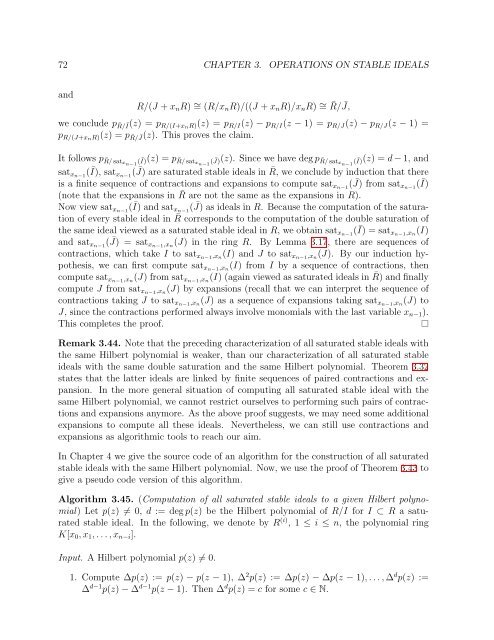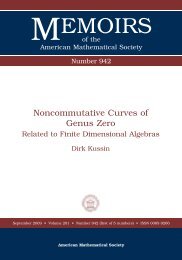University of Paderborn Department of Mathematics Diploma Thesis ...
University of Paderborn Department of Mathematics Diploma Thesis ...
University of Paderborn Department of Mathematics Diploma Thesis ...
You also want an ePaper? Increase the reach of your titles
YUMPU automatically turns print PDFs into web optimized ePapers that Google loves.
72 CHAPTER 3. OPERATIONS ON STABLE IDEALSandR/(J + x n R) ∼ = (R/x n R)/((J + x n R)/x n R) ∼ =¯R/ ¯J,we conclude p ¯R/ Ī(z) = p R/(I+xnR)(z) = p R/I (z) − p R/I (z − 1) = p R/J (z) − p R/J (z − 1) =p R/(J+xnR)(z) = p ¯R/ ¯J(z). This proves the claim.It follows p ¯R/ satxn−1 (Ī) (z) = p ¯R/ satxn−1 ( ¯J)(z). Since we have deg p ¯R/ satxn−1 (Ī) (z) = d − 1, andsat (Ī), sat xn−1 x n−1( ¯J) are saturated stable ideals in ¯R, we conclude by induction that thereis a finite sequence <strong>of</strong> contractions and expansions to compute sat xn−1 ( ¯J) from sat (Ī) xn−1(note that the expansions in ¯R are not the same as the expansions in R).Now view sat (Ī) and sat xn−1 x n−1( ¯J) as ideals in R. Because the computation <strong>of</strong> the saturation<strong>of</strong> every stable ideal in ¯R corresponds to the computation <strong>of</strong> the double saturation <strong>of</strong>the same ideal viewed as a saturated stable ideal in R, we obtain sat (Ī) = sat xn−1 x n−1 ,x n(I)and sat xn−1 ( ¯J) = sat xn−1 ,x n(J) in the ring R. By Lemma 3.17, there are sequences <strong>of</strong>contractions, which take I to sat xn−1 ,x n(I) and J to sat xn−1 ,x n(J). By our induction hypothesis,we can first compute sat xn−1 ,x n(I) from I by a sequence <strong>of</strong> contractions, thencompute sat xn−1 ,x n(J) from sat xn−1 ,x n(I) (again viewed as saturated ideals in ¯R) and finallycompute J from sat xn−1 ,x n(J) by expansions (recall that we can interpret the sequence <strong>of</strong>contractions taking J to sat xn−1 ,x n(J) as a sequence <strong>of</strong> expansions taking sat xn−1 ,x n(J) toJ, since the contractions performed always involve monomials with the last variable x n−1 ).This completes the pro<strong>of</strong>.Remark 3.44. Note that the preceding characterization <strong>of</strong> all saturated stable ideals withthe same Hilbert polynomial is weaker, than our characterization <strong>of</strong> all saturated stableideals with the same double saturation and the same Hilbert polynomial. Theorem 3.32states that the latter ideals are linked by finite sequences <strong>of</strong> paired contractions and expansion.In the more general situation <strong>of</strong> computing all saturated stable ideal with thesame Hilbert polynomial, we cannot restrict ourselves to performing such pairs <strong>of</strong> contractionsand expansions anymore. As the above pro<strong>of</strong> suggests, we may need some additionalexpansions to compute all these ideals. Nevertheless, we can still use contractions andexpansions as algorithmic tools to reach our aim.In Chapter 4 we give the source code <strong>of</strong> an algorithm for the construction <strong>of</strong> all saturatedstable ideals with the same Hilbert polynomial. Now, we use the pro<strong>of</strong> <strong>of</strong> Theorem 3.43 togive a pseudo code version <strong>of</strong> this algorithm.Algorithm 3.45. (Computation <strong>of</strong> all saturated stable ideals to a given Hilbert polynomial)Let p(z) ≠ 0, d := deg p(z) be the Hilbert polynomial <strong>of</strong> R/I for I ⊂ R a saturatedstable ideal. In the following, we denote by R (i) , 1 ≤ i ≤ n, the polynomial ringK[x 0 , x 1 , . . . , x n−i ].Input. A Hilbert polynomial p(z) ≠ 0.1. Compute ∆p(z) := p(z) − p(z − 1), ∆ 2 p(z) := ∆p(z) − ∆p(z − 1), . . . , ∆ d p(z) :=∆ d−1 p(z) − ∆ d−1 p(z − 1). Then ∆ d p(z) = c for some c ∈ N.
















